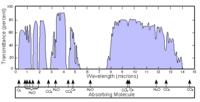
Photo from wikipedia
Abstract. The information content of thermal infrared measurements for tropospheric ozone (O 3 ) estimation has already been well demonstrated. However, the impact of such measurements to constrain modelled O… Click to show full abstract
Abstract. The information content of thermal infrared measurements for tropospheric ozone (O 3 ) estimation has already been well demonstrated. However, the impact of such measurements to constrain modelled O 3 distributions within global assimilation systems is not yet unequivocal. A new tropospheric O 3 reanalysis is computed for the year 2010 by means of assimilating measurements from the Infrared Atmospheric Sounding Interferometer (IASI) within the MOdele pour la Chimie A Grande Echelle (MOCAGE) chemical transport model. The objective is to evaluate the impact of recent methodological improvements of the data assimilation scheme on the O 3 distribution. The new O 3 reanalysis (named IASI-r) and its precursor (IASI-a) have been validated against ozonesondes, and compared to independent estimations of tropospheric O 3 and to results from two state-of-the-art products based on detailed tropospheric chemistry (the Goddard Earth Observing System with a coupled chemistry–climate model, GEOS-CCM, and the Copernicus Atmosphere Monitoring Service, CAMS, reanalysis). The main difference between IASI-r and IASI-a concerns the treatment of IASI observations, with radiances being assimilated directly in IASI-r instead of intermediate Level 2 O 3 retrievals. IASI-r is found to correct major issues with IASI-a, such as the neutral or negative impact of IASI assimilation in the extra-tropics and the presence of residual biases in the tropics. IASI-r also compares relatively well to the CAMS reanalysis, which is based on a more comprehensive chemical mechanism and the assimilation of several ultraviolet (UV) and microwave measurements.
Journal Title: Geoscientific Model Development
Year Published: 2021
Link to full text (if available)
Share on Social Media: Sign Up to like & get
recommendations!